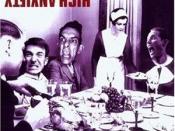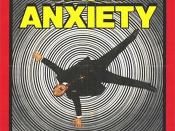ABSTRACT. Undergraduate university students (N = 103) participated in a study of the relationship between test anxiety and the variables of trait anxiety, self-esteem, locus of control, mental ability, and gender. Results indicated bivariate associations between total test anxiety and the other measures except for mental ability. Further analyses revealed independent relationships between the "worry" component of test anxiety and the variables of trait anxiety, internality, chance, and mental ability. We also found independent associations between the "emotionality" aspect of test anxiety and the measures of trait anxiety and chance.
THE TRADITIONAL CONCEPT OF NEUROSIS embraces a wide range of behaviors, but the common core (neurotic nucleus) is a maladaptive lifestyle characterized by anxiety. Neurotics tend to evaluate everyday problems as threatening, feel inadequate, doubt their capacity to cope with adjustive demands, and deal with the resulting anxiety by avoidance and defense-oriented reactions (Coleman, Butcher, & Carson, 1984).
We hypothesized that test anxiety is a situation-specific form of neurosis.
Consonant with the neurotic nucleus concept, we expected that the behavior would be related to anxiety disposition, self-esteem, locus of control, mental ability, and gender.
Spielberger (1966) differentiated between state and trait anxiety. State anxiety is a transitory emotional reaction invoked in persons who perceive particular situations as threatening; trait anxiety refers to stable individual differences in anxiety proneness. Spielberger, Gorsuch, and Lushene (1970) and Lazarus (1966) noted that people with trait anxiety appraise many situations as threatening. Assuming that individuals with trait anxiety anticipate traumatic events more often, we expected that they would experience test anxiety more frequently.
Neurotics generally lack self-esteem. Rheinberg (1982) viewed this lack as a critical factor in test anxiety, and Many and Many (1975)and Shoemaker (1980) found negative correlations between the two variables. Our hypothesis concerning the relationship between self-esteem and test anxiety reflected these...



Very good
Very good and useful.
0 out of 0 people found this comment useful.